tire pressure AUDI A8 2018 Owners Manual
[x] Cancel search | Manufacturer: AUDI, Model Year: 2018, Model line: A8, Model: AUDI A8 2018Pages: 356, PDF Size: 54.71 MB
Page 6 of 356
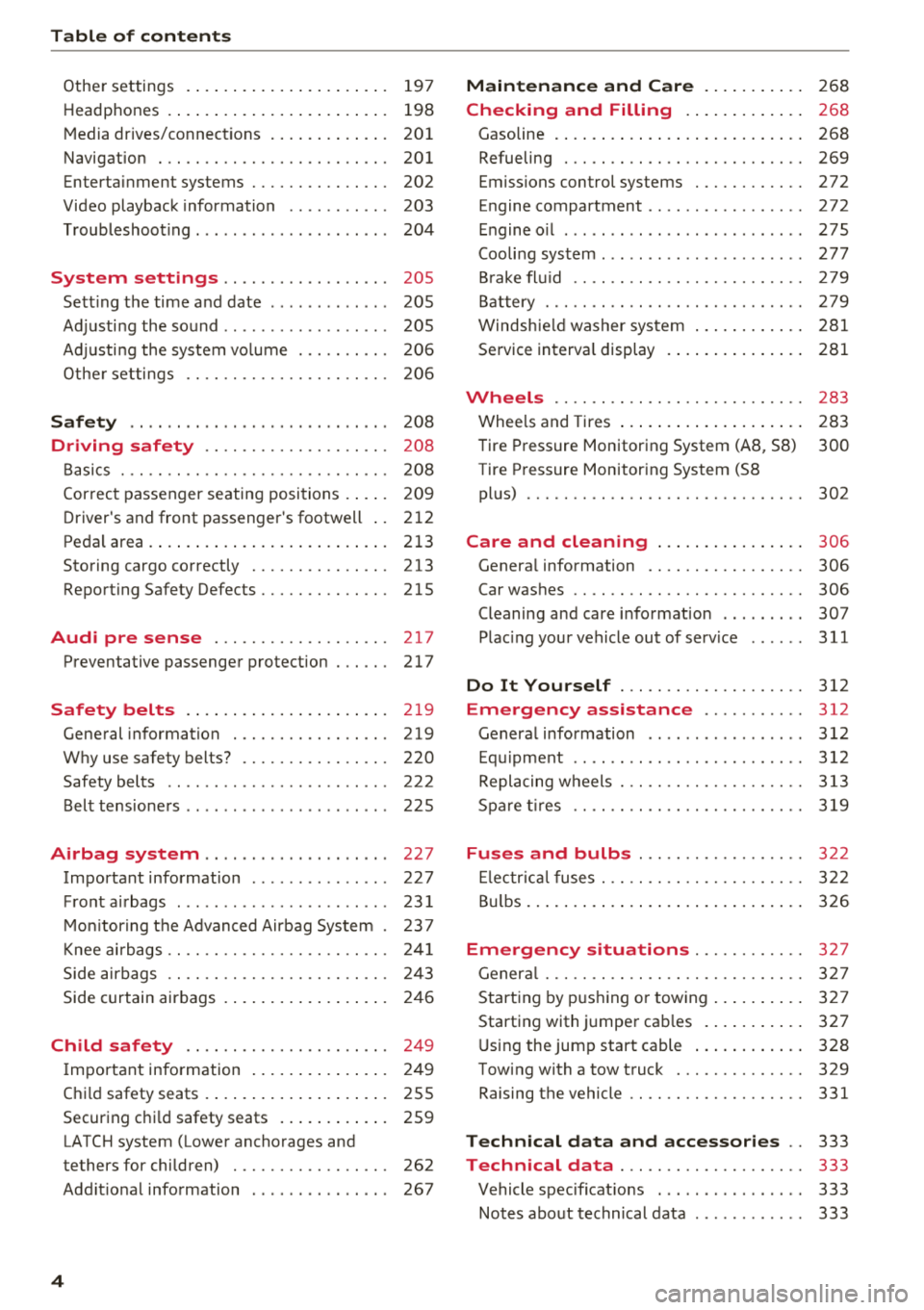
Table of contents
Other settings . . . . . . . . . . . . . . . . . . . . . . 197
H eadphon es . . . . . . . . . . . . . . . . . . . . . . . . 198
M edia drives/connect ions . . . . . . . . . . . . . 201
Navigation . . . . . . . . . . . . . . . . . . . . . . . . . 201
Enterta inment systems . . . . . . . . . . . . . . . 202
Video playback information . . . . . . . . . . . 203
T roubleshoot ing . . . . . . . . . . . . . . . . . . . . . 204
System settings . . . . . . . . . . . . . . . . . . 205
Sett ing the time and date . . . . . . . . . . . . . 205
Ad justi ng the sound . . . . . . . . . . . . . . . . . . 205
Ad justi ng the system vo lume ... .... .. .
Othe r settings .. ............. .. .. .. . 206
206
Safety .. .. .. .. ... .. ..... ... .. .. .. . 208
Driving safety . . . . . . . . . . . . . . . . . . . . 208
B asics . . . . . . . . . . . . . . . . . . . . . . . . . . . . . 20 8
Cor rect passenger seating positions . . . . . 209
D river's and front passenge r's footwell . . 212
Peda l area. ........ .. ..... ... .. .. ... 213
Storing cargo correctly . . . . . . . . . . . . . . . 213
Report ing Safety Defects....... .... .. . 215
Audi pre sense . . . . . . . . . . . . . . . . . . . 217
Preventative passenger protection . . . . . . 217
Safety belts . . . . . . . . . . . . . . . . . . . . . . 2 19
Gene ral information . . . . . . . . . . . . . . . . . 219
W hy use safety belts? . . . . . . . . . . . . . . . . 220
Safety belts . . . . . . . . . . . . . . . . . . . . . . . . 222
Belt tensioners . . . . . . . . . . . . . . . . . . . . . . 225
Airbag system . . . . . . . . . . . . . . . . . . . . 227
Important information . . . . . . . . . . . . . . . 227
F ront a irbags . . . . . . . . . . . . . . . . . . . . . . . 23 1
M on itor ing t he Advanced Airbag System . 237
Knee ai rbags . . . . . . . . . . . . . . . . . . . . . . . . 24 1
Side air bags . . . . . . . . . . . . . . . . . . . . . . . . 24 3
Side c urtain airbags . . . . . . . . . . . . . . . . . . 246
Child safety . . . . . . . . . . . . . . . . . . . . . . 24 9
I mportant info rmation . . . . . . . . . . . . . . . 24 9
Chi ld safety seats . . . . . . . . . . . . . . . . . . . . 255
Securing chi ld safety seats . . . . . . . . . . . . 259
LATCH system (Lower anchorages and
tethers for children) . . . . . . . . . . . . . . . . . 262
Add it io nal information . . . . . . . . . . . . . . . 267
4
Maintenance and Care . . . . . . . . . . . 2 68
Checking and Filling . . . . . . . . . . . . . 268
Gasoline . . . . . . . . . . . . . . . . . . . . . . . . . . . 268
Refueling . . . . . . . . . . . . . . . . . . . . . . . . . . 269
Emissions control systems . . . . . . . . . . . . 272
Engine compartment . . . . . . . . . . . . . . . . . 272
E ngine o il . . . . . . . . . . . . . . . . . . . . . . . . . . 275
Cooli ng system . . . . . . . . . . . . . . . . . . . . . . 277
B rake fl uid . . . . . . . . . . . . . . . . . . . . . . . . . 279
Bat tery . . . . . . . . . . . . . . . . . . . . . . . . . . . . 279
Windsh ie ld washer sys tem . . . . . . . . . . . . 281
Service in terva l display 281
Wheels .... .. .. .. .. ............. .. 28 3
Whee ls and Tires . . . . . . . . . . . . . . . . . . . . 283
T ire Pressure Monitoring System (AB , 58) 300
Tire P ressure Monitor ing System (58
pl us) . . . . . . . . . . . . . . . . . . . . . . . . . . . . . . 302
Care and cleaning . . . . . . . . . . . . . . . . 306
Genera l information . . . . . . . . . . . . . . . . . 306
Car washes . . . . . . . . . . . . . . . . . . . . . . . . . 306
Cleaning and care info rmation . . . . . . . . . 307
Plac ing your vehicle out of serv ice . . . . . . 311
Do It Yourself . . . . . . . . . . . . . . . . . . . . 312
Emergency assistance . . . . . . . . . . . 312
Genera l information . . . . . . . . . . . . . . . . . 312
E qu ipment . . . . . . . . . . . . . . . . . . . . . . . . . 312
Repla cing wheels . . . . . . . . . . . . . . . . . . . . 313
Spa re tir es . . . . . . . . . . . . . . . . . . . . . . . . . 319
Fuses and bulbs . . . . . . . . . . . . . . . . . . 32 2
El ec trica l fuses . . . . . . . . . . . . . . . . . . . . . . 322
B ul bs . . . . . . . . . . . . . . . . . . . . . . . . . . . . . . 3 26
Emergency situations . . . . . . . . . . . . 327
Gener al . . . . . . . . . . . . . . . . . . . . . . . . . . . . 32 7
Start ing by p ushi ng o r tow ing . . . . . . . . . . 3 27
Starting with jumper cab les . . . . . . . . . . . 327
U sing the jump start cable . . . . . . . . . . . . 328
Towing with a tow truck . . . . . . . . . . . . . . 329
Raising the vehicle . . . . . . . . . . . . . . . . . . . 331
Technical data and a ccessories . . 333
Technical data . . . . . . . . . . . . . . . . . . . . 333
Vehicle specificat ions . . . . . . . . . . . . . . . . 333
Notes abo ut technical data . . . . . . . . . . . . 333
Page 20 of 356
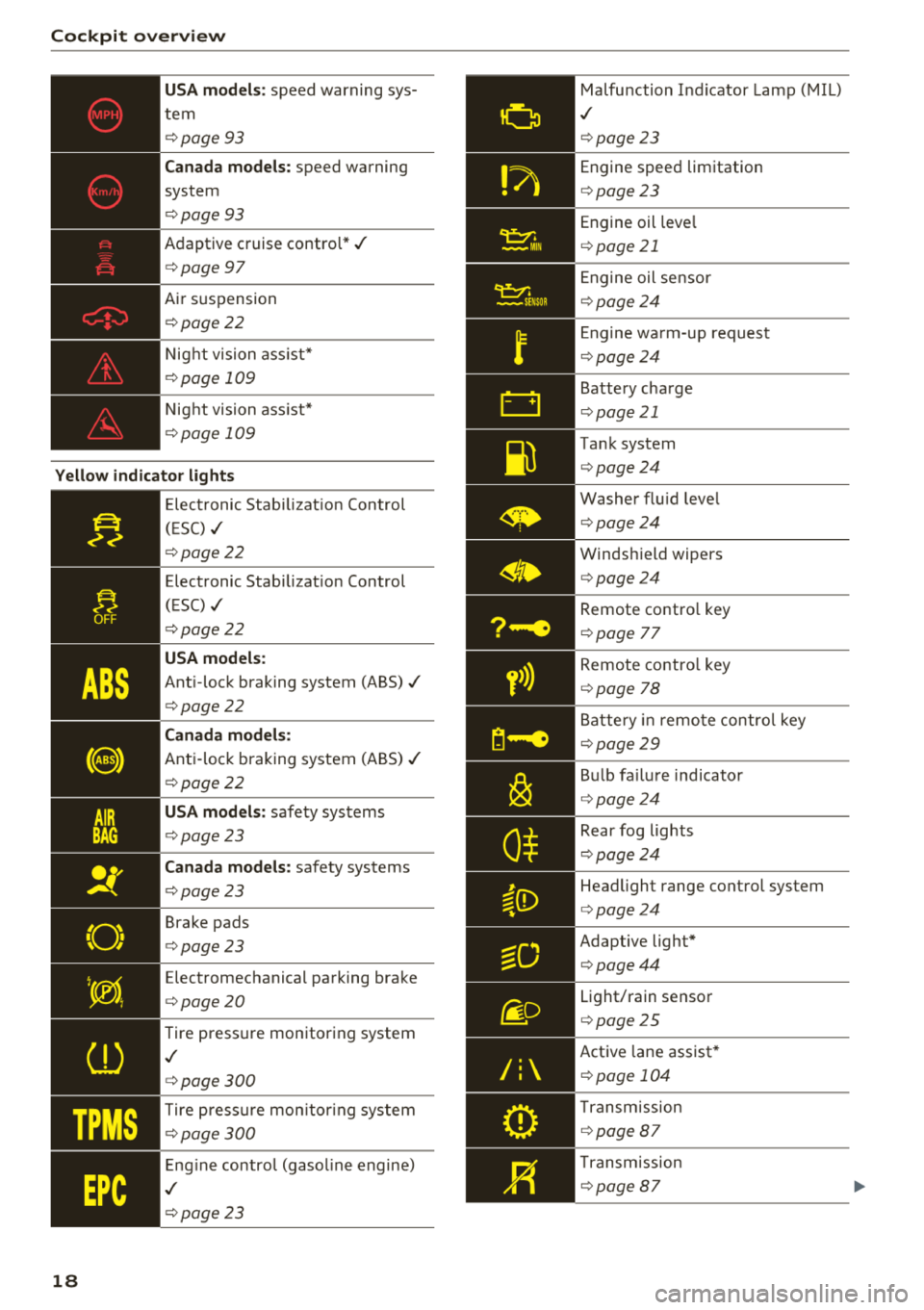
Cockpit overv ie w
USA mod els : speed warning sys
tem
¢ page 93
Ca nad a models: speed warning
system
¢ page93
Adaptive cruise contro l*./
¢ page 97
Air s uspension
¢ page22
Night vision ass ist*
¢ page 109
Night vision ass ist*
¢ page 109
Yello w indic ator light s
18
-------------Elect ronic Stab ilizat ion Control
( E SC)
./
¢ page 22
Electronic Stabilizat ion Control
(ESC)
./
¢ page22
USA models:
Ant i-lock braking system (ABS)./
¢page22
Canada mod els:
Anti -loc k braking system (ABS) ./
¢ page22
USA mod els: safety systems
¢ page23
Ca nad a models: safety systems
¢ page23
Brake pads
¢ page23
Electromechanical parking brake
¢ page20
Tire pressure monitoring system
.I
¢page300
Tire p ress ure mon itor ing system
¢ page 300
Eng ine control (gasol ine engine)
.I
¢ page23
Malfunction Indicator Lamp (MIL)
.I
¢page23
Engine speed limitation
¢ page23
Engine oil leve l
¢page 21
Engine oil sensor
¢page24
Engine wa rm-up request
¢ page24
Battery charge
¢page 21
Tank system
¢page24
Washer flu id leve l
¢page24
Windshield wipers
¢page24
Remote contro l key
¢ page 77
Remote contro l key
¢ page 78
Battery in remote contro l key
¢page29
Bu lb fa ilu re indicator
¢ page24
Rear fog lights
¢page24
Headlight range control system
¢page24
Adaptive light*
¢page44
Light/rain sensor
¢page 25
Active lane assist *
¢page 104
Transm ission
¢ page 87
Transm ission
¢page 87
Page 76 of 356
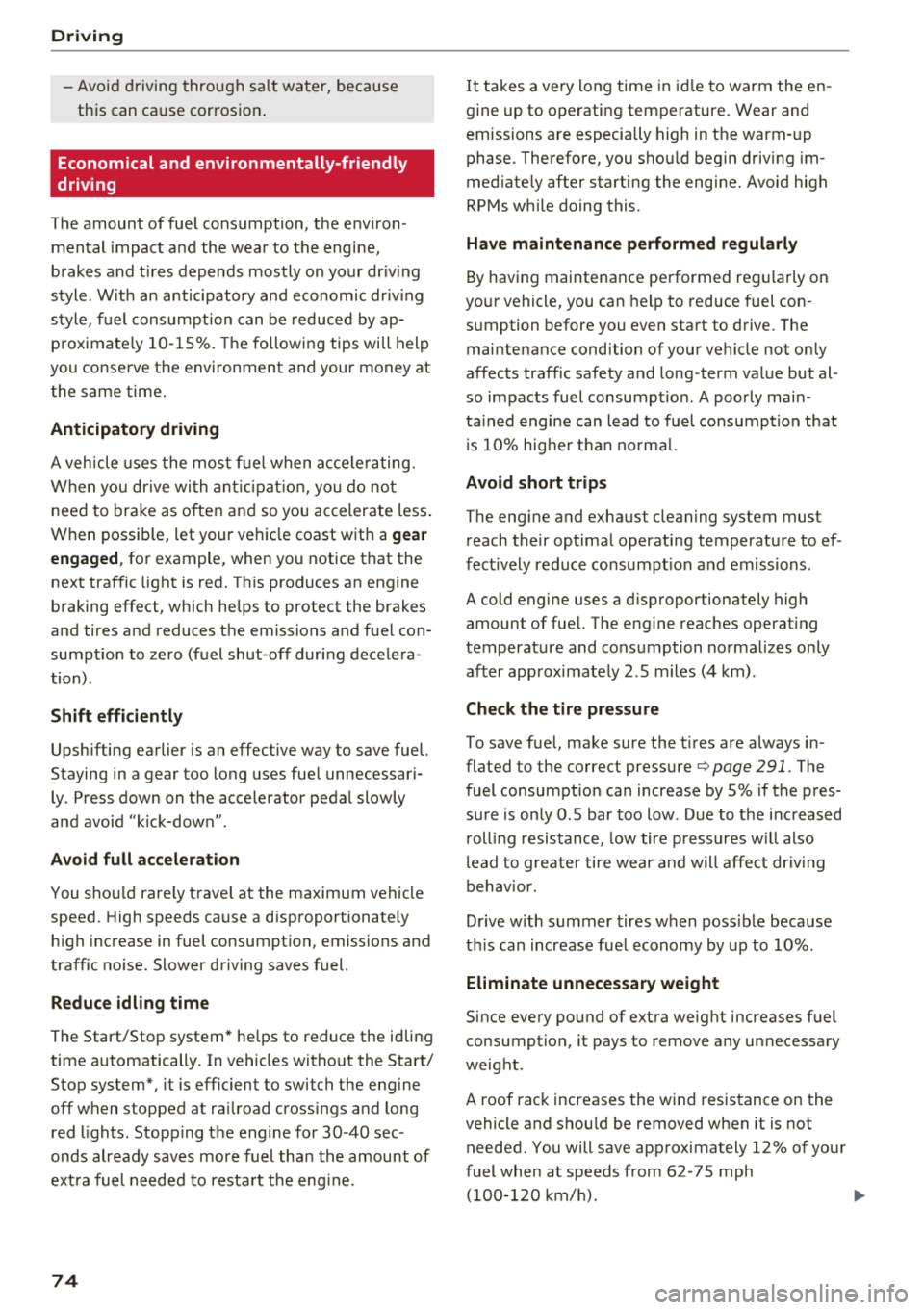
Drivin g
-Avoid driving through sa lt water, because
this can cause corrosion .
Economical and environmentally-friendly
driving
The amount of fuel consumption, the env iron
mental impact and the wear to the engine,
brakes and t ires depends mostly on your dr iv ing
style. W it h an anticipatory and economic dr iv ing
style , fu el consumption can be reduced by ap
p roximate ly 10 -15% . The following tips wi ll help
you conserve the environment and your money at the same time .
Anticipatory driving
A veh icle uses the most fuel when acce le rating.
When you dr ive with ant ic ipat io n, you do no t
need to brake as often and so you accelerate less .
When possib le, let your vehicle coast with a
gear
eng aged ,
for example, when you notice that the
next traffic light is red. This produces an engine
braking effect, which helps to protect the brakes
and tires and reduces the emissions and fuel con
sumpt ion to zero (fuel shut -off during decelera
tion) .
Shift efficientl y
Upshifting earlier is an effective way to save fuel.
Staying in a gear too long uses fue l unnecessari
ly . Press down on the accelerator pedal slowly
and avoid "k ick-down" .
Avoid full accel eration
You shou ld rare ly trave l at the maximum vehicle
speed. High speeds cause a disproportionately h igh increase in fuel consumption, emissions and
traffic no ise . Slower driving saves fuel.
Reduce idlin g time
The Start/Stop system* he lps to reduce the idling
time automatically. In vehicles without the Start/
Stop system*, it is efficient to switch the eng ine
off when stopped at ra ilroad crossings and long
red l ights . Stopp ing the engine for 30 -40 sec
onds already saves more fuel than the amount of
ext ra fuel needed to resta rt the eng ine.
74
It takes a ve ry long time in id le to warm the en
gine up to operating temperature. Wear and
emissions are especially high in the warm -up
phase. Therefore, you shou ld begin driving im
med iate ly after starting the engine. Avoid high
RPMs while doing this .
Hav e maintenance perfo rmed regul arly
By having maintenance performed reg ularly on
your vehicle, you can help to reduce fuel con
sumption before you even start to drive. The maintenance condition of your vehicle not on ly
affects traffic safety and long-term value but al
so impacts fuel consumpt ion. A poorly main
ta ined engine can lead to fuel consumpt ion that
i s 10% hig he r th an no rma l.
Avoid short trip s
The engine and exhaust cleaning system must
reach their optimal operat ing temperature to ef
fect ively reduce consumpt ion and emissions .
A cold engine uses a d isproportionately high
amount of fuel. The engine reaches operat ing
temperature and consumption normalizes only
after approximately 2 .5 m iles (4 km) .
Check the tire pressu re
To save fue l, make sure the t ires are always in
flated to the correct pressure
¢ page 291. The
fuel consumpt ion can increase by 5% if the pres
sure is only 0 .5 bar too low . Due to the increased
r oll ing resistance, low tire p ressures w ill also
l ead to greater tire wear and will affe ct driv ing
behav ior.
Drive w ith summer tires when poss ible because
t hi s can increase fue l economy by up to 10% .
Eliminate unnecessary weight
Since every pound of extra weight increases fuel
consumption, it pays to remove any unnecessary
weight.
A roof rack increases the w ind resistance on the
vehicle and shou ld be removed when it is not
needed. You will save approximately 12% of your
fuel when at speeds from 62-75 mph (100-120 km/ h).
.,.
Page 92 of 356
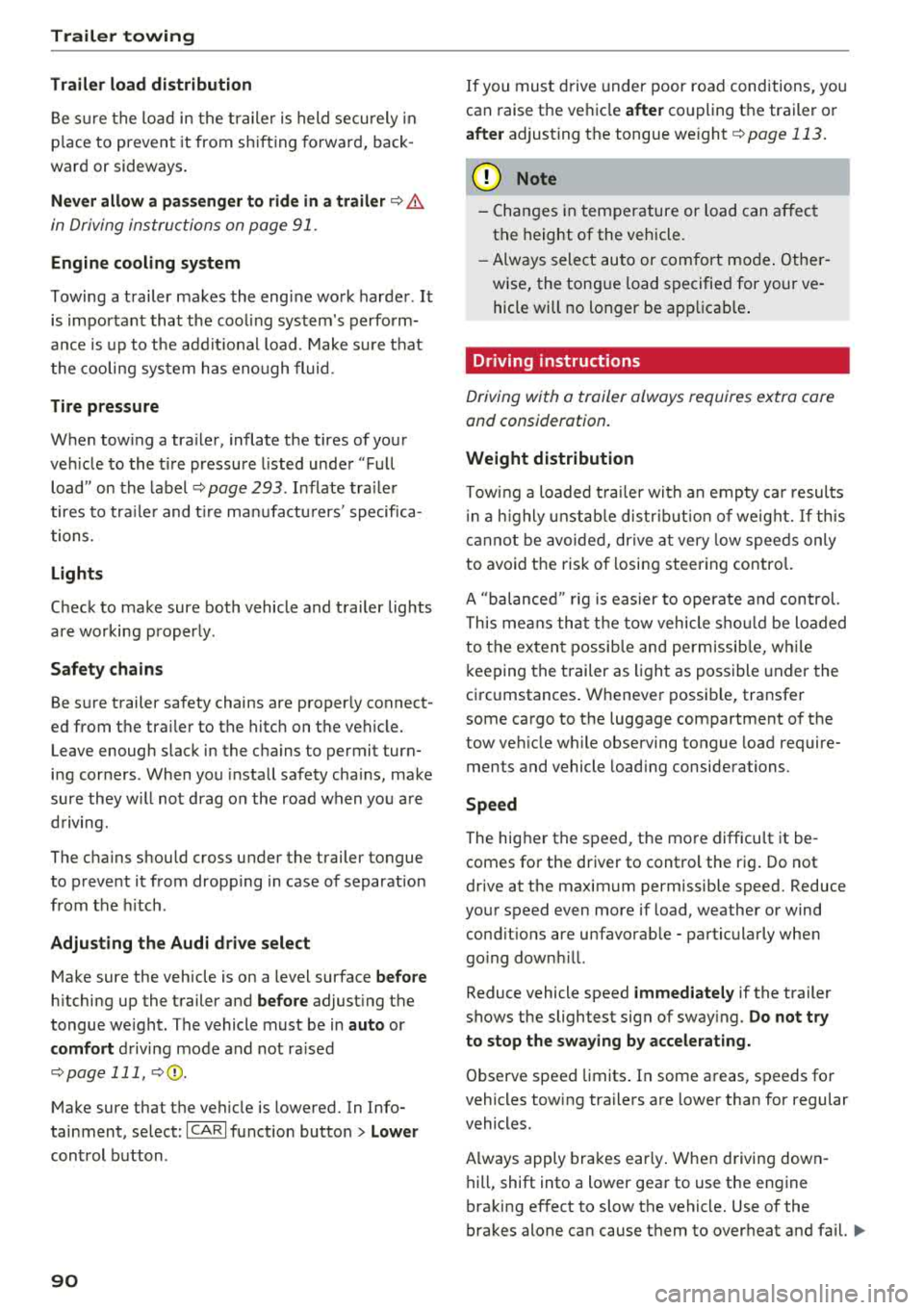
Trailer towing
Trailer load distribution
Be sure the load in the trailer is held securely in
p la ce to prevent it from shifting forward, back
ward or sideways .
Never allow a passenger to ride in a trailer~&.
in Driving instructions on page 91.
Engine cooling system
Towing a trailer makes the engine work harder . It
is important that the coo ling system's perform
ance is up to t he additional load. Make sure that
the cooling system has eno ugh fluid .
Tire pressure
When tow ing a tra iler, inflate the tires of your
veh icle to the tire pressure listed under "Full
load " on the label
~ page 293. Inflate trailer
tires to trailer and tir e ma nufactu rers' specifica
tions.
Lights
Check to make sure both vehicle and trailer lights
are working properly .
Safety chains
Be sure trailer safety chains are proper ly connect
ed from the trailer to the hitch on the vehicle.
Leave enough slack in the chains to permit turn
ing corners . When you install safety cha ins, make
sure they w ill not drag on the road when you are
driving.
The chains should cross under the trailer tongue
to prevent it from dropping in case of separation
from the hitch .
Adjusting the Audi drive select
Make sure the vehicle is on a level surface before
hitching up the trailer and before adjust ing the
tongue we ight. The vehicle must be in
auto or
comfort driving mode and not ra ised
~ page 111, ~0 .
Make sure that the vehicle is lowered. In Info
tainment, select:
ICARI function butto n> Lower
control button.
90
If you must drive under poor road conditions, you
can raise the ve hicle
after coupling the trailer or
after adjust ing the tongue we ight ~ page 113.
@ Note
-Changes in temperature or load can aff ect
the height of the vehicle .
-Always select auto or comfort mode. Other
wise, the tong ue load specified for your ve
hicle will no longer be applicab le .
Driving instructions
Driving with a trailer always requires extra care
and consideration.
Weight distribution
Towing a loaded trailer with an empty car results
in a hig hly unstable distribution of we ight. If th is
cannot be avoided, drive at very low speeds only
to avoid t he risk of losing steering contro l.
A "balanced" rig is eas ier to operate and control.
This means that the tow vehicle s hould be loaded
to
the extent possible and permissib le, w hil e
keeping the trailer as light as possible under the
circumstances. Whenever possible, transfer
some cargo to the luggage compartment of the
tow veh icle while observing tongue load require
ments and vehicle loading considerations.
Speed
The higher the speed, the more difficu lt it be
comes for the driver to control the rig . Do not
drive at the maximum permissible speed. Reduce
your speed even more if load, weather or wind cond it ions are unfavorable - particularly whe n
go ing down hill.
Reduce vehicle speed
immediately if the trailer
shows the slightest sign of sway ing.
Do not try
to stop the swaying by accelerating.
Observe speed limits. In some areas, speeds for
vehicles towing trailers are lower than for regular
vehicles.
A lways apply brakes early. When driving down
hill, shift into a lower gear to use the engine
braking effect to slow the vehicle. Use of the
brakes alone can cause them to overheat and fail.
ll-
Page 210 of 356
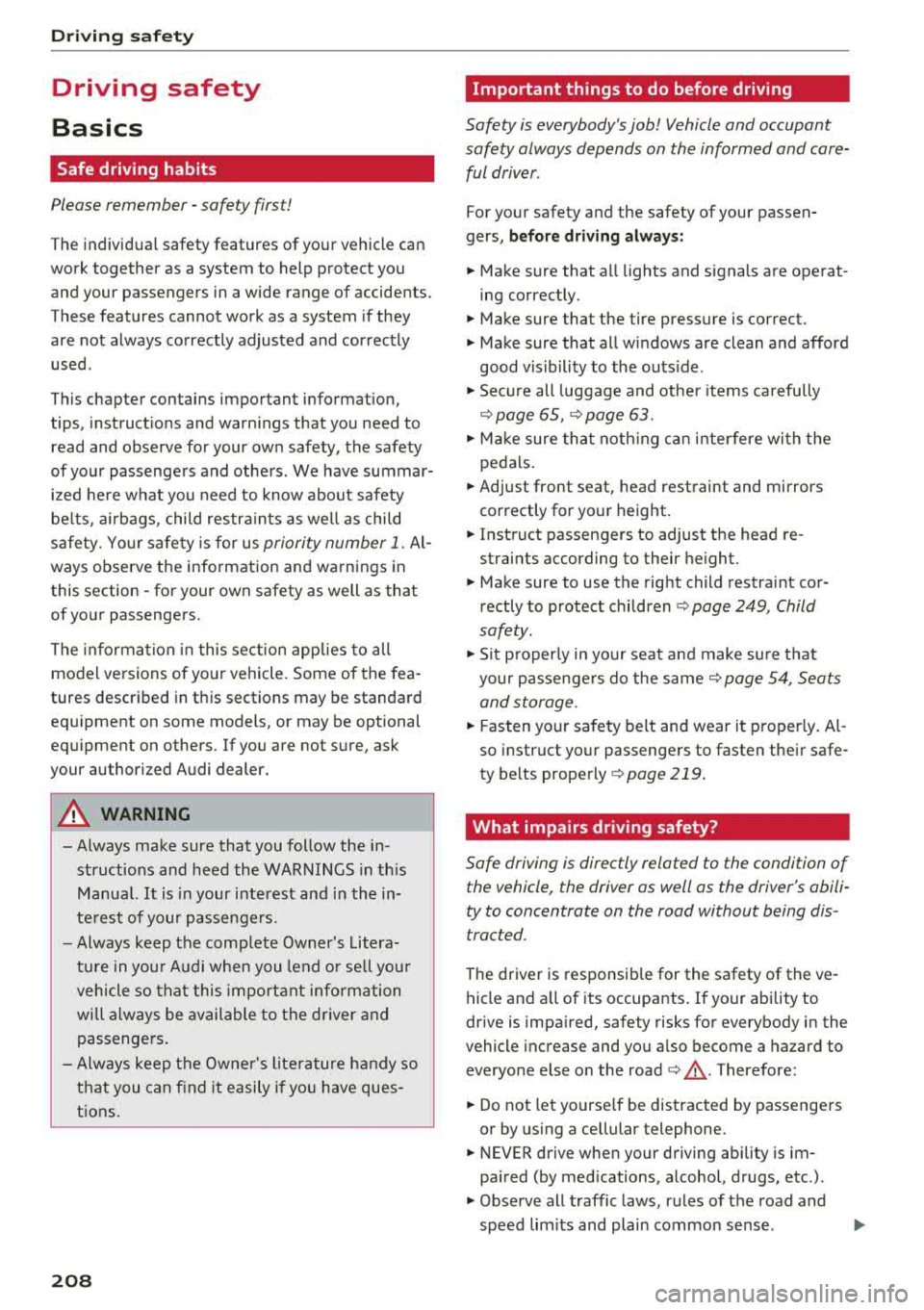
Drivin g saf ety
Driving safety
Basics
Safe driving habits
Please remember -safety first!
The individua l safety features of your vehicle can
work together as a system to help protect you
and your passengers in a wide range of accidents.
These features cannot work as a system if they
are not always correctly adjusted and correctly
used .
This chapter contains important informat ion,
tips, instruct ions and warn ings that you need to
read and observe for your own safety, the safety
of you r passengers and others . We have summar
ized here w hat you need to know about safety
be lts, a irbags, child restra ints as well as child
safety. Yo ur safety is for us
priority number 1. Al
ways observe the information and warnings in
this section -for your own safety as we ll as that
of your passengers.
The information in this section applies to all
model versions of your vehicle . Some of the fea
tures described in this sections may be standard
equipment on some models, or may be optional
equ ipment on others. If you are not sure, ask
your author ized Audi dealer.
A WARNING
- Always make sure that you follow the in
structions and heed the WARNINGS in th is
Manua l.
It is in your interest and in the in
te rest of your passengers .
-
-Always keep the complete Owner's Litera
tu re in you r A udi when you lend or se ll you r
vehicle so that this import ant information
will always be available to the d river and
passengers.
- Always keep the Owner 's lite rature h andy so
that you can find it easily if you have ques
tions .
208
Important things to do before driving
Safety is everybody's job! Vehicle and occupant
safety always depends on the informed and care
ful driver .
For your safety and the safety of your passen
gers,
bef ore dri ving alw ays:
.. Make sure that a ll lights and signals are operat
ing correctly .
.. Make sure that the tire pressure is correct.
.. Make sure that all windows are clean and afford
good vis ibility to the outs ide .
.. Sec ure all luggage and othe r items ca refully
¢ page 65, ¢page 63 .
.. Make sure tha t noth ing ca n interfere wi th the
peda ls .
.. Adjust front seat, head restraint and mirrors
correctly for your height.
.. Instruct passengers to adjust the head re
straints according to their he ight.
.. Make sure to use the right child restraint cor
rectly to protect
children ¢ page 249, Child
safety .
• Sit proper ly in yo ur seat a nd make sure t hat
your passenge rs do the same
¢ page 54, Seats
and storage.
.. Fasten your sa fety belt and wear it p roperly . Al
so instruct your passengers to fasten their safe
ty be lts properly
¢ page 219 .
What impairs driving safety?
Safe driving is directly related to the condition of
the vehicle, the driver as well as the driver's abili
ty to concentrate on the road without being dis
tracted.
The driver is responsib le for the safety of the ve
hicle and a ll of its occupants. If your ability to
drive is impa ired, safety risks for everybody in the
vehicle increase and you a lso become a hazard to
everyone else on the road
¢ _&. . Therefore:
.. Do not let yourse lf be distracted by passenge rs
or by using a cellular telephone .
.. NEVER drive when your driving ability is im
paired (by med ications, alcohol, drugs, etc .) .
.. Observe all traffic laws, rules of the road and
speed lim its and plain common sense .
.,.
Page 216 of 356
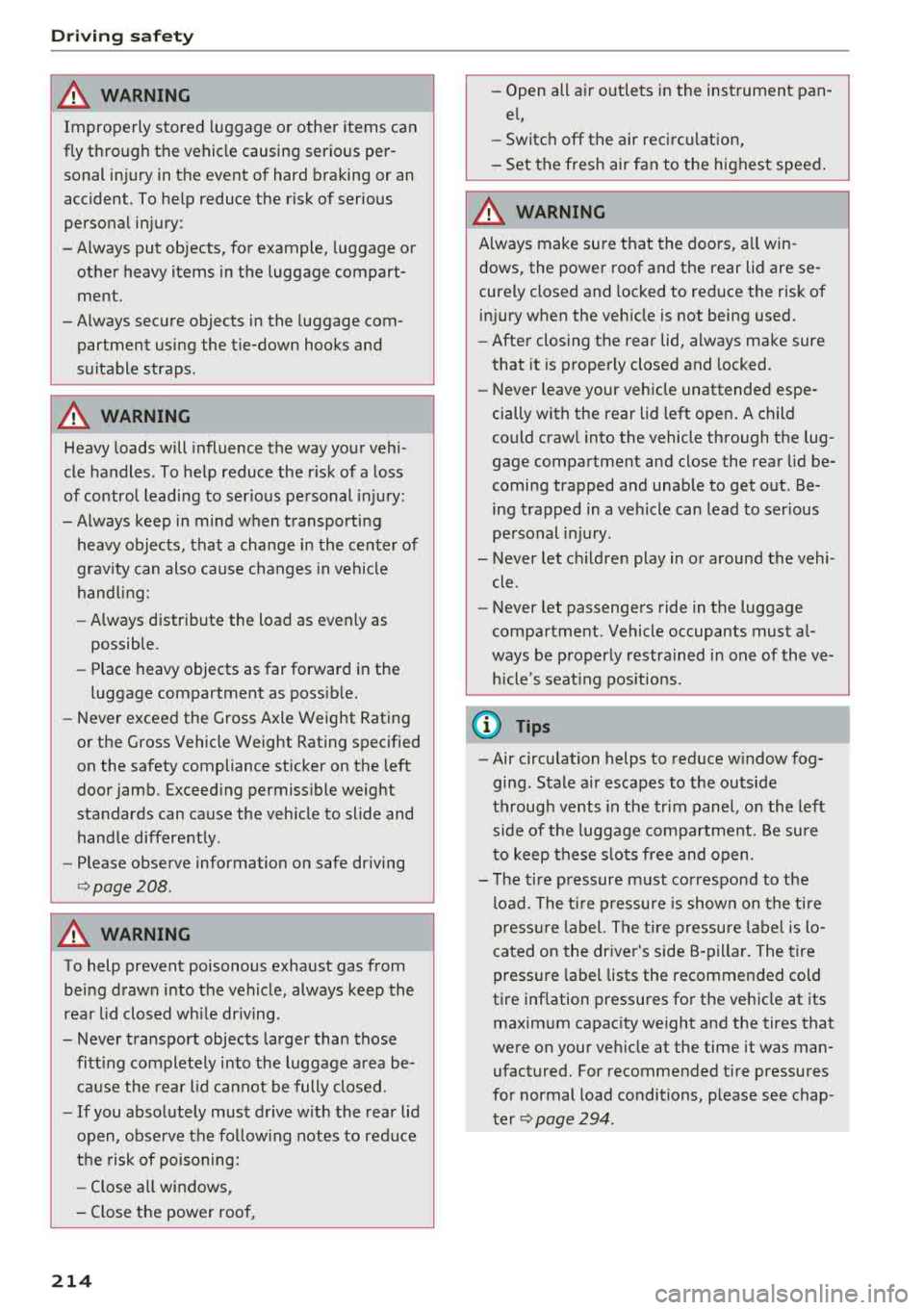
Drivin g saf ety
A WARNING
Improperly stored luggage or other items can
fly through the vehicle causing serious per sonal injury in the event of hard braking or an
accident. To help reduce the risk of serious
personal injury:
- Always put objects, for example, luggage or other heavy items in the luggage compart
ment.
- Always secure objects in the luggage com
partment using the tie-down hooks and
suitable straps .
A WARNING
Heavy loads will influence the way your vehi
cle handles. To help reduce the r isk of a loss
of control leading to serious pe rsonal injury:
- Always keep in mind when transporting heavy objects, that a change in the center of
grav ity can also cause changes in vehicle
hand ling:
- Always distribute the load as even ly as
possible.
- Place heavy objects as far forward in the
luggage compartment as poss ible.
- Never exceed the Gross Axle Weight Rating
o r the Gross Vehicle Weight Rating specified
on the safety compliance sticker on the left
doo r jamb. Exceed ing permissible weight
standards can cause the vehicle to slide and
hand le differently .
- Please observe information on safe driving
c> page 208.
A WARNING
To help prevent poisonous exhaust gas from
being d rawn into the vehicle, always keep the
rear lid closed whi le driving.
- Never transport objec ts larger than those
fi tt ing complete ly into the luggage a rea be
ca use the rear l id cannot be fully closed.
- If you absolutely mus t drive w ith the rea r lid
open, obse rve the follow ing notes to reduce
t h e risk of poisoning:
- Close all windows,
- Close the power roof,
214
-
- Open all a ir outlets in the instrument pan
el,
- Switch off the air reci rculat ion
'
- Set the fresh air fan to the highest speed .
A WARNING -
Always make su re that the doo rs, all win
dows, the powe r roof and the rear lid are se
curely closed and locked to re duce the risk of
in jury when the veh icle is not being used.
- After closing the rear lid, always ma ke sure
that it is properly closed and locked.
- Never leave your veh icle unattended espe
cially with the rear lid left open . A child
could crawl into the vehicle through the lug
gage compartment and close the rea r lid be
coming trapped and unab le to get o ut. Be
ing trapped in a vehicle can lead to ser ious
pe rsonal injury.
- Never let ch ildren play in o r around the vehi
cle.
- Never let passengers ride in the luggage
compa rtment . Vehicle occupants mus t al
ways be properly restrained in one of the ve hicle's seat ing pos itions.
(D Tips
- Air circulation helps to reduce w indow fog
ging . Stale ai r esca pes to the outs ide
through vents in the trim panel, on the left
side of the luggage compartment. Be sure
to keep t hese s lo ts free and open.
- T he tire p ressure must correspond to the
load. The t ire pressure is shown on t he tire
press ure label. The ti re pre ssure label is lo
c ated on the drive r's side B- pilla r. The tire
pressu re label lists the recommen ded cold
t ire inflation pressures fo r the veh icle at its
maximum capac ity we ight and the tires that
we re on your veh icle at the time it was man
ufactured . For recommended t ire pressures
for normal load conditions, p lease see chap
ter
c> page 294.
Page 287 of 356
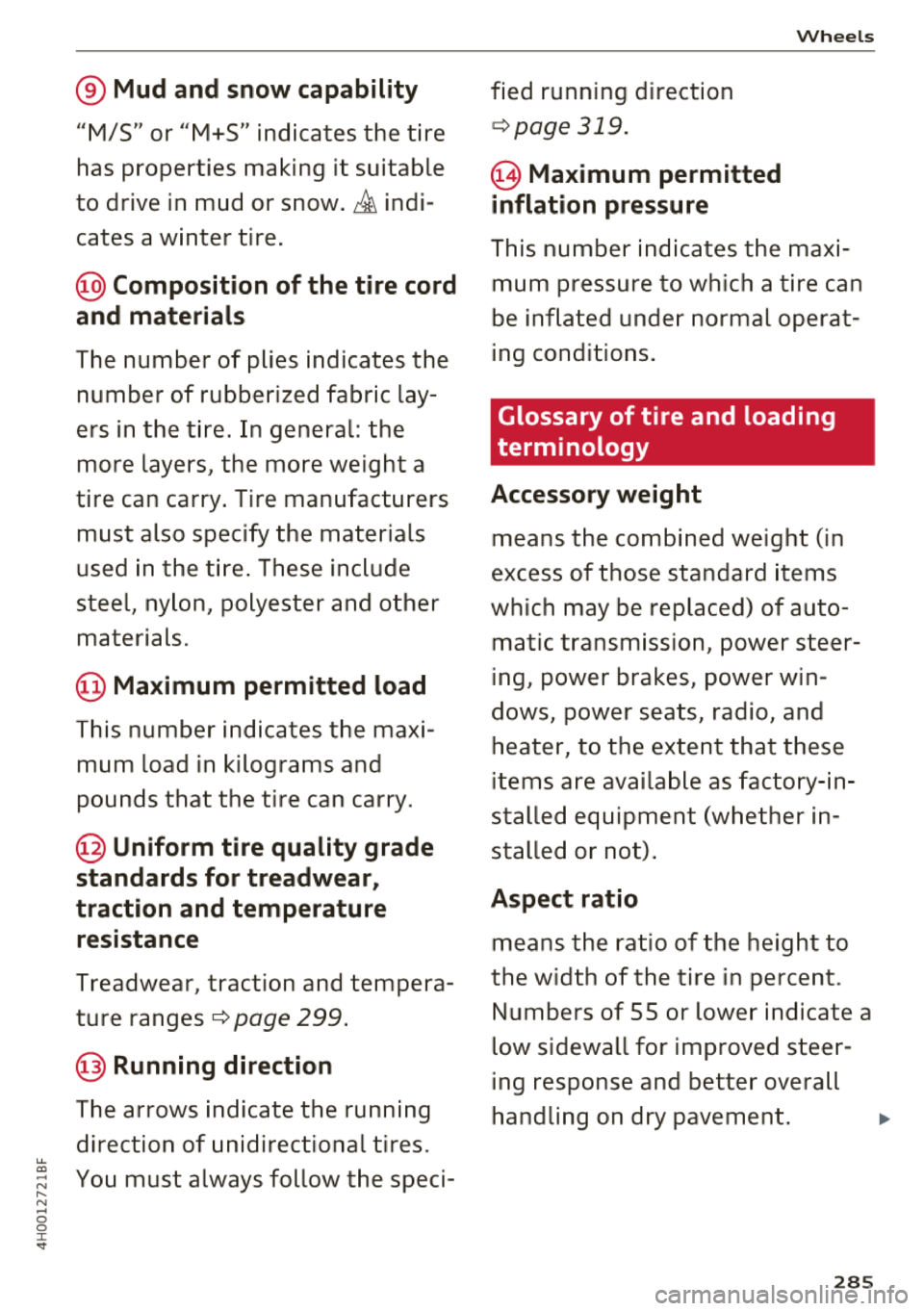
....
"' -N .... N
-0
0
J: ..
® Mud and snow capability
"M/S" or "M+S" indicates the tire
has properties making it suitable
to drive in mud or
snow .~ indi
cates a winter tire .
@ Composition of the tire cord
and m aterials
The number of plies indicates the
number of rubberized fabric lay
ers in the tire. In general : the
more layers, the more weight a
tire can carry . Tire manufacturers
must also specify the materials
used in the tire . These include
steel, nylon, polyester and other
materials .
@Maximum permitted load
This number indicates the maxi
mum load in kilograms and
pounds that the tire can carry .
@Uniform ti re quality grade
standards for treadwear,
traction and temperature resistance
Treadwear , traction and tempera
ture
ranges¢ page 299 .
@ Running direction
The arrows indicate the running
direction of unidirectional tires .
You must always follow the speci- fied running direction
¢
page 319.
@ Maximum permitted
inflation p ressure
Wh eel s
This number indicates the maxi
mum pressure to which a tire can
be inflated under normal operat
ing conditions.
Glossary of tire and loading
terminology
Accessory weight
means the combined weight (in
excess of those standard items
which may be replaced) of auto matic transmission, power steer
ing, power brakes, power win
dows, power seats, radio, and
heater, to the extent that these
items are available as factory-in
stalled equipment (whether in
stalled or not) .
Aspect ratio
means the ratio of the height to
the width of the tire in percent .
Numbers of 55 or lower indicate a
low sidewall for improved steer
ing response and better overall
handling on dry pavement .
285
Page 288 of 356
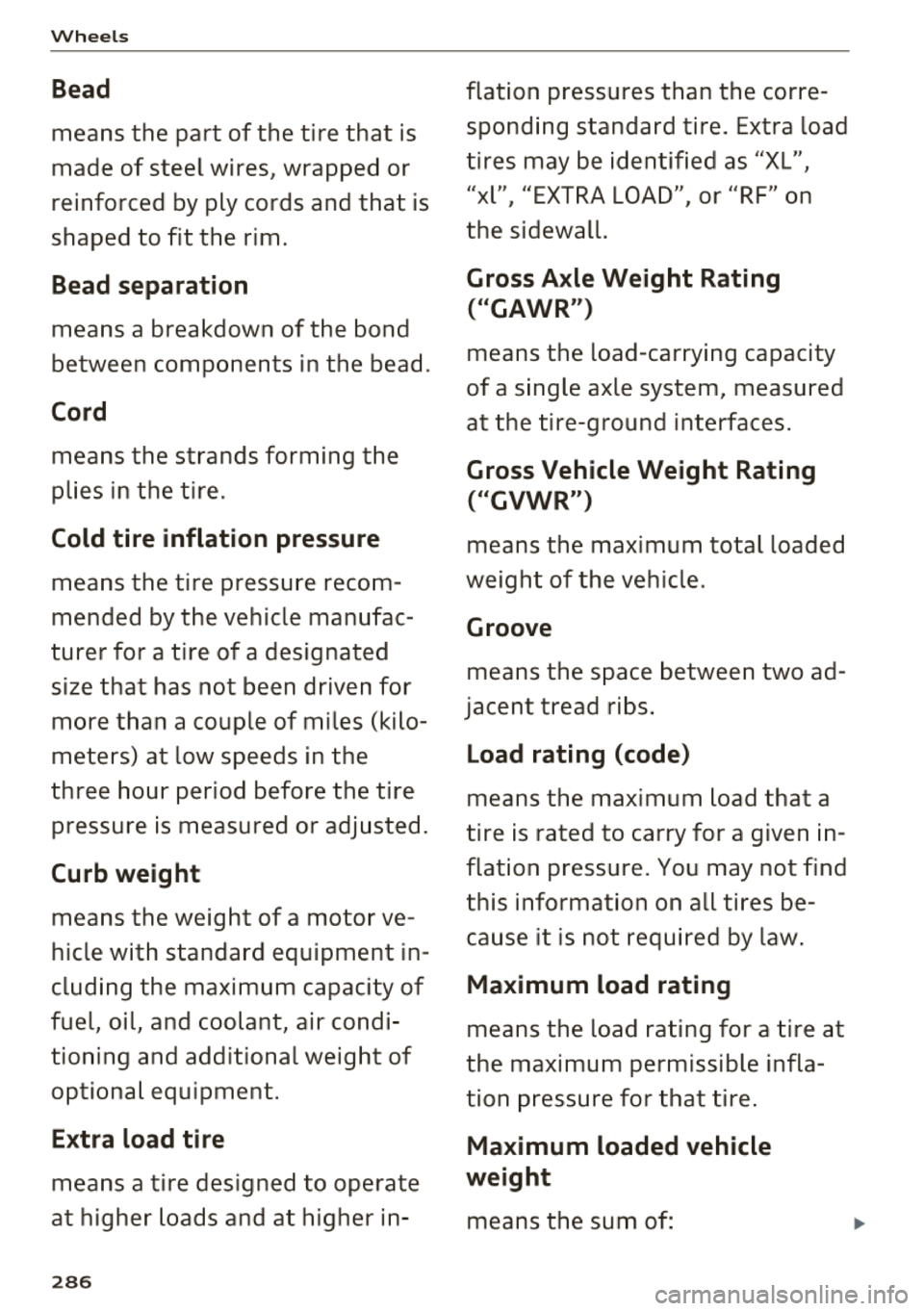
Wheels
Bead
means the part of the tire that is
made of steel wires, wrapped or
reinforced by ply cords and that is
shaped to fit the rim .
Bead separation
means a breakdown of the bond
between components in the bead .
Cord
means the strands forming the
plies in the tire .
Cold tire inflation pressure
means the tire pressure recom
mended by the vehicle manufac
turer for
a tire of a designated
size that has not been driven for more than a couple of miles (kilo
meters) at low speeds in the
three hour period before the tire pressure is measured or adjusted .
Curb weight
means the weight of a motor ve
hicle with standa rd equipment in
cluding the maximum ca pacity of
fuel, oil, and coolant, air condi
tioning and addit ional weigh t of
optional equipment.
E x tra load tire
means a tire designed to operate
at higher loads and at higher
in -
28 6
flation pressures than t he corre
spond ing standard tire. Extra load
tires may be identified as "X L",
"xl" , "EXTRA LOAD" , or "RF" on
the sidewall.
Gross Axle Weight Rating ("GAWR")
means the load-car rying capacity
of a single axle system , measu red
at the ti re-ground interfaces .
Gross Vehicle Weight Rating
("GVWR")
means the maximum total loaded
weight of the vehicle .
Groove
means the space between two ad
jacent tread ribs .
Load rating (code)
means the maximum load tha t a
tire is rated to carry for a given i n
flation pressure. You may no t find
this informat ion on all ti res be
cause it is not required by law .
Maximum load rating
means the load rating for a tire at
the maximum permissible infla
tion pressure for that tire .
Maximum loaded vehicle
weight
means t he sum of:
Page 289 of 356
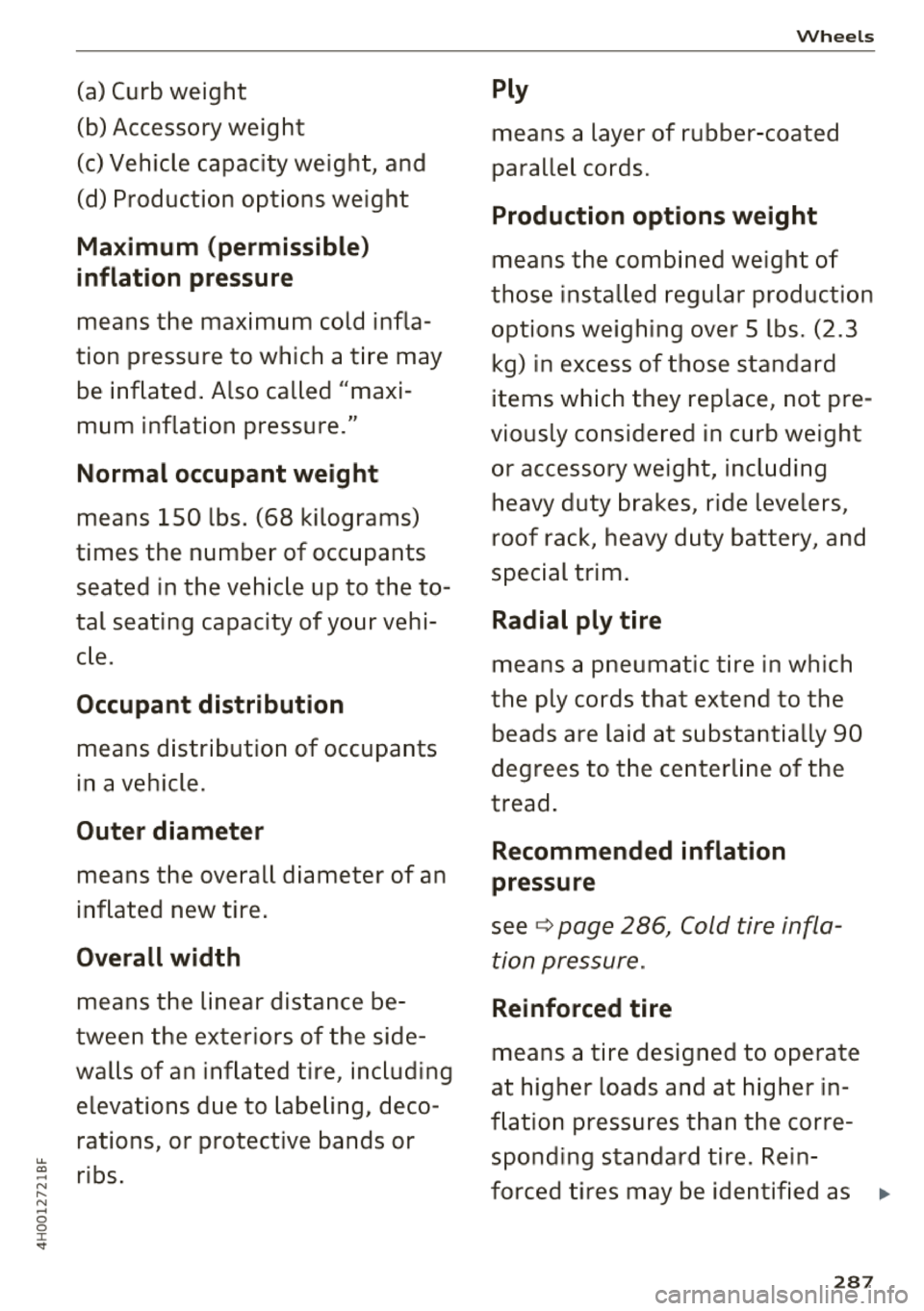
....
"' -N .... N
-0
0
J: ..
(a) Curb weight
(b) Accessory weight
(c) Vehicle capacity weight, and
(d) Production options weight
Ma ximum (permissible }
inflation pres sure
means the maximum cold infla
tion pressure to which a t ire may
be inflated . Also called "maxi
mum inflation pressure."
Normal occupant weight
means 150 l bs. (68 kilograms)
times the number of occupants
seated in the veh icle up to the to
tal seating capacity of your vehi
c le.
Occupant distribution
means distribution of occupants
in a vehicle.
Outer diameter
means the overall diameter of an
inflated new tire .
Overall width
means the linear distance be
tween the exteriors of the side
walls of an inflated tire, including
elevations due to labeling, deco
rations, or protective bands or
ribs .
Wheels
Ply
means a layer of rubber-coated
parallel cords .
Production options weight
means the combined weight of
those installed regular production
options weighing over 5 lbs. (2.3 kg) in excess of those standard
items which they replace, not pre
viously considered in curb weight
or accessory weight, including heavy duty brakes , ride levelers ,
roof rack, heavy duty battery, and
special trim .
Radial ply tire
means a pneumatic tire in which
the ply cords that extend to the beads are laid at substantially 90
degrees to the centerline of the
tread .
Recommended inflation
pressure
see ~ page 286, Cold tire infla
tion pressure .
Reinforced tire
means a tire designed to operate
at higher loads and at higher in
flat ion pressures than the corre
sponding standard tire. Rein
forced tires may be iden tified as
.,.
28 7
Page 290 of 356
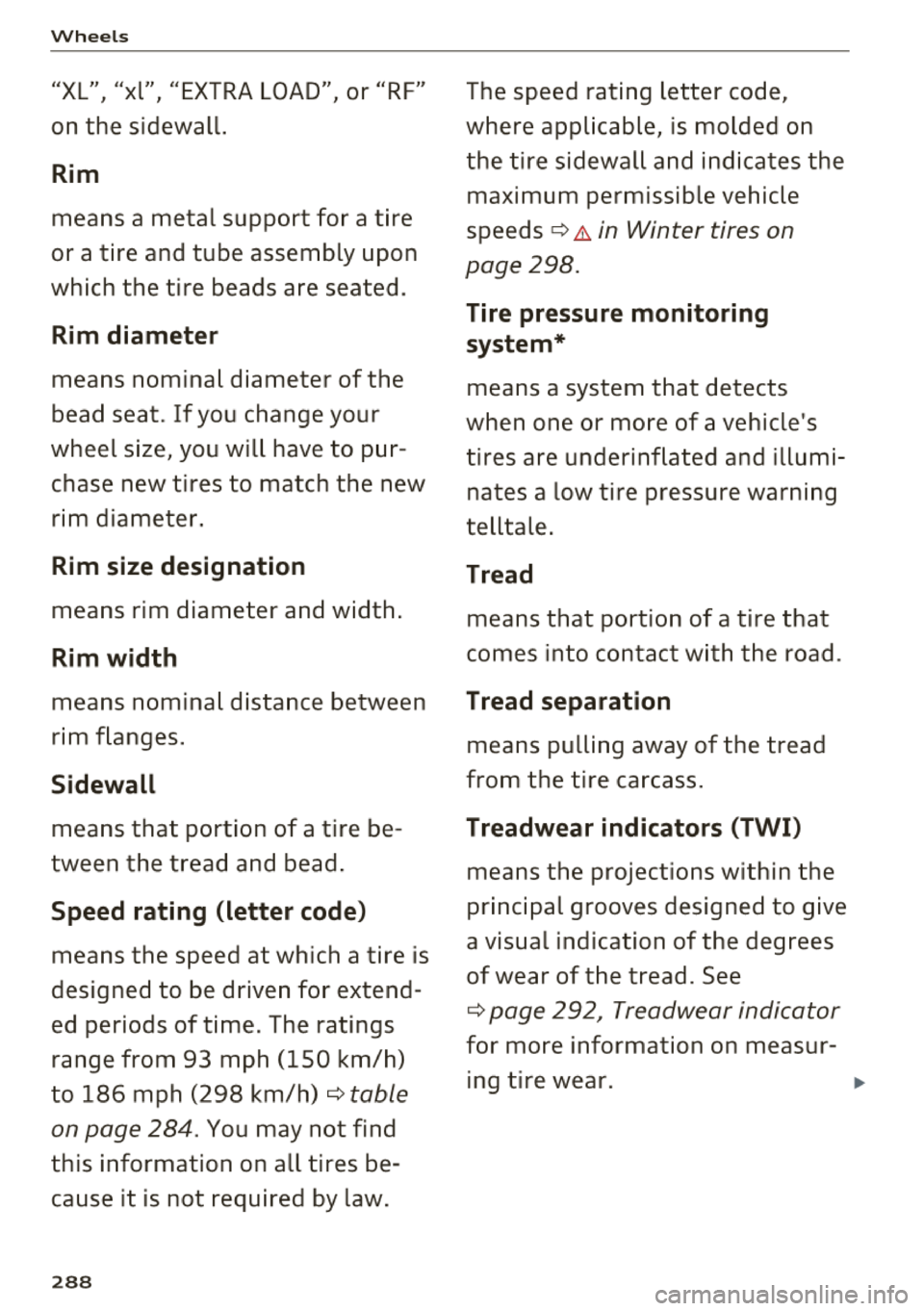
Wheels
"XL" "xl" "EXTRA LOAD" or "RF" I I I
on the sidewall.
Rim
means a metal support for a tire
or a tire and tube assembly upon
which the tire beads are seated.
Rim diameter
means nominal diameter of the
bead seat . If you change your
wheel size, you will have to pur
chase new tires to match the new rim diameter .
Rim size designation
means rim diameter and width .
Rim width
means nominal distance between
rim flanges.
Sidewall
means that portion of a tire be
tween the tread and bead .
Speed rating (letter code)
means the speed at which a tire is
designed to be driven for extend
ed periods of time. The ratings range from 93 mph (150 km/h)
to 186 mph (298
km/h)¢ table
on page 284 .
You may not find
this information on all tires be
cause it is not required by law .
288
The speed rating letter code,
where applicable, is molded on the tire sidewall and indicates the maximum permissible vehicle
speeds
¢ .1,. in Winter tires on
page 298 .
Tire pressure monitoring
system*
means a system that detects
when one or mo re of a vehicle 's
tires are underinflated and illumi
nates a low tire pressure warning
telltale .
Tread
means that portion of a tire that
comes into contact with the road .
Tread separation
means pulling away of the tread
from the tire carcass .
Treadwear indicators (TWI )
means the projections within the
principal grooves designed to give
a visual indication of the degrees
of wear of the tread. See
¢ page 292, Treadwear indicator
for more information on measur- ing tire wear.
.,.